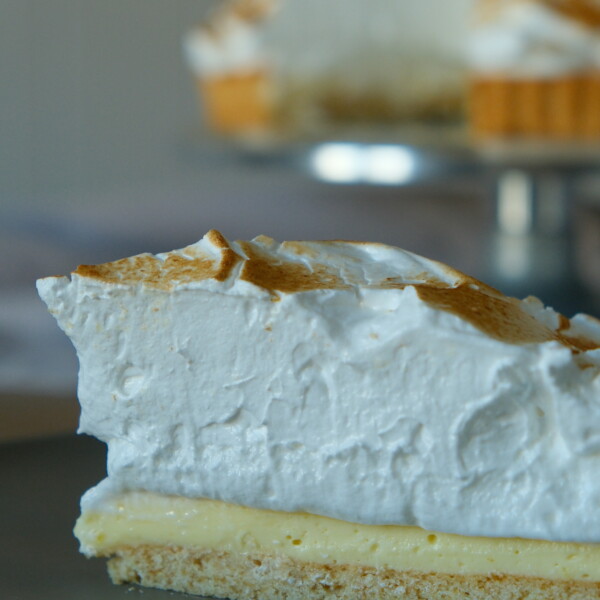Lemon Meringue Tart
This stunning Lemon Meringue Tart is the perfect ‘wow factor’ dessert for a special occasion. Imagine golden, almond-infused pastry topped with a layer of zesty lemon curd, finished with sweet caramelised meringue… it is just too good to resist!
- Prep Time: 45 mins
- Chill Time: 2 hours
- Cook Time: 15 mins
- Total Time: 1 hour + chill time
- Yield: 8-12 1x
- Category: Baking
- Method: Oven
- Cuisine: French
Ingredients
For the pastry:
- 100 g unsalted butter, at room temperature
- 55 g icing sugar
- 40 g egg (approximately 1 small egg)
- Plus 1 egg yolk
- 170g plain flour, plus extra for rolling
- 20 g ground almonds
- 3 g salt
For the lemon curd:
- 500 g lemons (approximately 3-4 lemons for zest and juice)
- 167 g butter, diced into cubes
- 250 g eggs (approximately 5 large eggs)
- 250 g caster sugar
- 6 g gelatine sheets (3.5 sheets but weighing it is a bit more accurate)
For the Italian meringue:
- 200 g egg whites (approximately 3 large egg whites)
- 400 g caster sugar
- 120 ml water
Instructions
- For the pastry: in the large bowl of an electric mixer, cream together the butter and icing sugar using the paddle attachment until well combined and smooth.
- Gradually add the eggs and beat until the mixture becomes light and airy - but not too fluffy.
- Sift in the flour, ground almonds and salt. Knead by hand to form a smooth dough. Shape into a ball, flatten into a disc, cover with cling film and chill for 30 minutes.
- Preheat the oven to 160°C Fan.
- Lightly dust a work surface and rolling pin with flour and roll out the pastry to a large circle, about ½ cm thick and about 10 cm larger on each side than your tart tin
- Use to line a 25cm (10-inch) loose-based tart tin. Prick the base with a fork.
- Bake for 10-15 minutes until golden brown and just sandy to touch. Allow to cool completely.
- Meanwhile, make the lemon curd: in a heat-proof bowl, mix together the lemon juice and zest, butter, eggs and sugar. Place over a pan of very gently simmering water, stirring constantly until the mixture thickens and coats the back of a spoon. Remove from heat and strain through a fine sieve to remove any lumps.
- Soften the gelatine in cold water for 2 minutes or until it’s completely soft. Remove from the water, squeeze out any excess liquid, then add to the warm lemon curd, stirring until completely dissolved. Leave the curd to cool for about 10 minutes.
- Pour the curd into the baked tart shell in a smooth and even layer. Leave to cool completely before chilling for 1 hour, or until set.
- Once the curd has set, prepare the Italian meringue: in a small saucepan, combine the sugar and water. Place over a medium heat until the sugar dissolves and the syrup reaches 118°C on a sugar thermometer.
- Meanwhile, in a clean, dry bowl, begin whisking the egg whites until they form soft peaks.
- Once the sugar syrup has reached the correct temperature, slowly pour it into the egg whites while continuing to whisk - take care to pour the syrup down the side of the bowl (not onto the whisks) to avoid splattering.
- Continue to whisk the egg whites until the meringue is glossy and forms stiff peaks, and the bowl has cooled to room temperature.
- To assemble: remove the tart from the tin and set onto a flat plate. Spread or pipe the Italian meringue over the set lemon curd. Use a blowtorch to lightly brown the meringue, or place under a grill for a few seconds - watch closely to prevent burning.
- Serve chilled or at room temperature decorated with lemon zest, if wished
Notes
Serving suggestions: this is also delicious served with seasonal berries, berry coulis and/or whipped cream.
If you want to use baking beads when you blind bake it, you can! But in all honestly I don’t tend to and as long as you prick it really well all over with a fork you should be fine. A good tip is if your pastry cracks when you bake it, brush it with a whisked egg and then pop it back in the oven to seal it in. Leave it cool and it will create a seal. You need it to be in great condition before you add the lemon mixture - because if it’s cracked, all the lemon mixture will leak out
Gelatine - I always tend to use the sheets as I just find them the easiest to work with. Soak them for a few minutes until they're soft and then squeeze them out and melt them into a little hot liquid in a pan. If you prefer to use the powdered kind, you can use the equivalent of course.
Find it online: https://desertislanddishes.co/lemon-meringue-tart/
